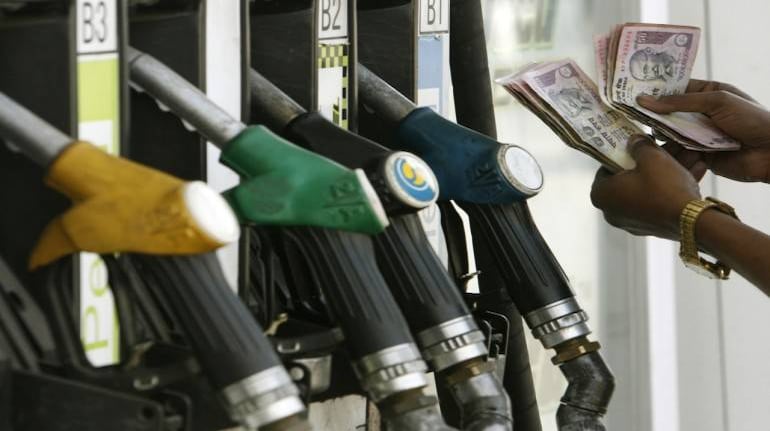



The retail price of fuel has been increasing consistently for a fortnight now but as much as it pinches to pay more, consumers were not surprised because there were enough indications that given the steep rise in crude oil prices, it was inevitable. But the 80-paise increase almost every day has left most consumers bewildered.
Unlike the snooze button on their morning alarm, the 80-paise increase alert in the morning does not seem to give a break.
State-owned oil marketing companies (OMCs) decide the retail price of fuel according to the rolling average of international benchmark prices over the previous 15 days; new prices come into effect at 6 am every day. While prices of fuel sold to bulk consumers and aviation turbine fuel were raised, retail prices of petrol and diesel were left unchanged for almost 137 days even though crude oil prices had risen sharply. Beginning March 22, OMCs have increased the prices on 13 of the last 15 days, almost every time by 80 paise. With the 80-paise increase on April 5, the total increase stands at Rs 9.20 per litre.
What is the magic figure of 80 paise?
“There is no special reason behind 80 paise,” three senior OMC executives told Moneycontrol. But all three added that there may have been a “gentle nudge” from the government to keep the daily increase under one rupee.
The government has time and again reiterated that the prices of petrol and diesel are market determined with effect from June 2010 and October 2014, respectively as their prices are being decided by the public sector oil marketing companies– Indian Oil Corporation Ltd (IOCL), Bharat Petroleum Corporation Ltd (BPCL), and Hindustan Petroleum Corporation Ltd (HPCL). But the OMCs' decision to leave the prices unchanged even as the Brent crude futures surged to highs of around $139 a barrel in early March from $80 a barrel in November triggered speculations that they were frozen due to the ongoing state elections in the period.
“The OMCs regularly increased prices by 10-25 paise earlier on a daily basis, but after they left it unchanged for a long time there was a need to increase it soon. That’s why they seem to be increasing it by a little under one rupee so that the public does not get a jolt. They could increase it for bulk users by Rs 25 in one go, but that cannot be done for retail users,” senior dealer K Suresh Kumar said.
Email queries sent to the OMCs for more clarity on their pricing strategy remained unanswered.
“It is not feasible for oil companies to increase prices in one go. In a highly volatile oil price environment, the government’s tax measures, whether by an increase or by reduction, lend stability to pump prices. One sees oil prices in India remaining largely stable or moving gradually in a particular direction. In short, the global volatility in oil prices is not reflected as much at the gas station,” Vikas Halan, associate managing director, corporate finance group, Moody’s Investors Service, told Moneycontrol.
In a report on March 24, Moody’s Investors Service had estimated that IOCL, BPCL and HPCL have together lost around $2.25 billion (Rs 19,000 crore) in revenue since November by keeping petrol and diesel prices unchanged.
So how many more 80-paise hikes should we expect?
OMC executives are tight-lipped about how much increase to expect and would the trend of an 80-paise hike in fuel prices a day continue.
“There is an under-recovery of around Rs 25 a litre, which is obvious from the price difference between the retail and bulk price of diesel. The general understanding is that the OMCs will try to recover this over the month, that pegs each increase at around 80 paise,” a senior executive from one of the OMCs said on condition of anonymity.
A series of increases in bulk high-speed diesel prices at a time when retail prices remained unchanged had resulted in a reversal of the trend, with the bulk diesel costing Rs 25 a litre more than the retail price before the March 22 increase in retail prices.
Another executive from one of the OMCs said that the increase is being rolled out on the assumption that crude oil prices may not spike as much as they did in March, but the pricing teams of all three OMCs are keeping a close vigil on global crude prices.
“The government’s current approach, that of gradual bite-sized increases in fuel prices, is consistent with its history of handling oil prices, i.e. not increasing pump prices at once. However, our concern is that this approach will result in oil marketing companies, such as IOCL, BPCL and HPCL continuing to make losses for longer,” Halan of Moody’s Investors Service said.
The benchmark Brent crude futures have come off highs to $105-110 a barrel but upwards pressure continues on geopolitical risks.
Discover the latest Business News, Sensex, and Nifty updates. Obtain Personal Finance insights, tax queries, and expert opinions on Moneycontrol or download the Moneycontrol App to stay updated!
Find the best of Al News in one place, specially curated for you every weekend.
Stay on top of the latest tech trends and biggest startup news.